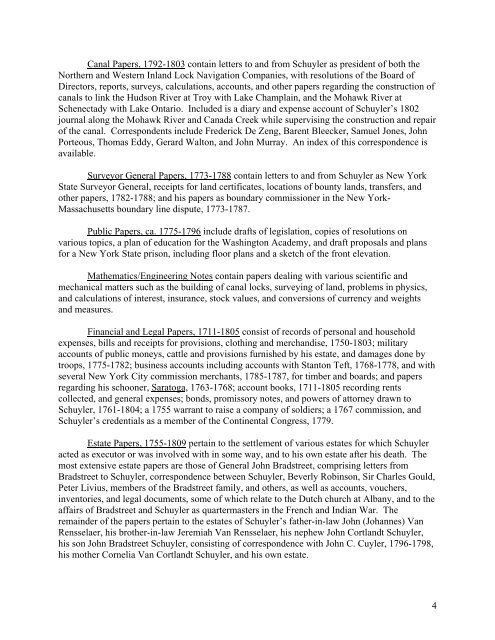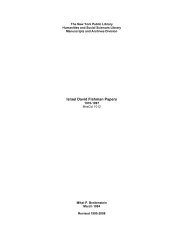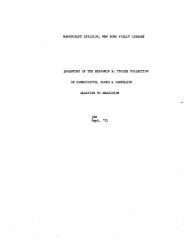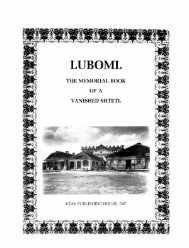Guide to the Philip Schuyler papers - New York Public Library
Guide to the Philip Schuyler papers - New York Public Library
Guide to the Philip Schuyler papers - New York Public Library
Create successful ePaper yourself
Turn your PDF publications into a flip-book with our unique Google optimized e-Paper software.
Canal Papers, 1792-1803 contain letters <strong>to</strong> and from <strong>Schuyler</strong> as president of both <strong>the</strong><br />
Nor<strong>the</strong>rn and Western Inland Lock Navigation Companies, with resolutions of <strong>the</strong> Board of<br />
Direc<strong>to</strong>rs, reports, surveys, calculations, accounts, and o<strong>the</strong>r <strong>papers</strong> regarding <strong>the</strong> construction of<br />
canals <strong>to</strong> link <strong>the</strong> Hudson River at Troy with Lake Champlain, and <strong>the</strong> Mohawk River at<br />
Schenectady with Lake Ontario. Included is a diary and expense account of <strong>Schuyler</strong>’s 1802<br />
journal along <strong>the</strong> Mohawk River and Canada Creek while supervising <strong>the</strong> construction and repair<br />
of <strong>the</strong> canal. Correspondents include Frederick De Zeng, Barent Bleecker, Samuel Jones, John<br />
Porteous, Thomas Eddy, Gerard Wal<strong>to</strong>n, and John Murray. An index of this correspondence is<br />
available.<br />
Surveyor General Papers, 1773-1788 contain letters <strong>to</strong> and from <strong>Schuyler</strong> as <strong>New</strong> <strong>York</strong><br />
State Surveyor General, receipts for land certificates, locations of bounty lands, transfers, and<br />
o<strong>the</strong>r <strong>papers</strong>, 1782-1788; and his <strong>papers</strong> as boundary commissioner in <strong>the</strong> <strong>New</strong> <strong>York</strong>-<br />
Massachusetts boundary line dispute, 1773-1787.<br />
<strong>Public</strong> Papers, ca. 1775-1796 include drafts of legislation, copies of resolutions on<br />
various <strong>to</strong>pics, a plan of education for <strong>the</strong> Washing<strong>to</strong>n Academy, and draft proposals and plans<br />
for a <strong>New</strong> <strong>York</strong> State prison, including floor plans and a sketch of <strong>the</strong> front elevation.<br />
Ma<strong>the</strong>matics/Engineering Notes contain <strong>papers</strong> dealing with various scientific and<br />
mechanical matters such as <strong>the</strong> building of canal locks, surveying of land, problems in physics,<br />
and calculations of interest, insurance, s<strong>to</strong>ck values, and conversions of currency and weights<br />
and measures.<br />
Financial and Legal Papers, 1711-1805 consist of records of personal and household<br />
expenses, bills and receipts for provisions, clothing and merchandise, 1750-1803; military<br />
accounts of public moneys, cattle and provisions furnished by his estate, and damages done by<br />
troops, 1775-1782; business accounts including accounts with Stan<strong>to</strong>n Teft, 1768-1778, and with<br />
several <strong>New</strong> <strong>York</strong> City commission merchants, 1785-1787, for timber and boards; and <strong>papers</strong><br />
regarding his schooner, Sara<strong>to</strong>ga, 1763-1768; account books, 1711-1805 recording rents<br />
collected, and general expenses; bonds, promissory notes, and powers of at<strong>to</strong>rney drawn <strong>to</strong><br />
<strong>Schuyler</strong>, 1761-1804; a 1755 warrant <strong>to</strong> raise a company of soldiers; a 1767 commission, and<br />
<strong>Schuyler</strong>’s credentials as a member of <strong>the</strong> Continental Congress, 1779.<br />
Estate Papers, 1755-1809 pertain <strong>to</strong> <strong>the</strong> settlement of various estates for which <strong>Schuyler</strong><br />
acted as execu<strong>to</strong>r or was involved with in some way, and <strong>to</strong> his own estate after his death. The<br />
most extensive estate <strong>papers</strong> are those of General John Bradstreet, comprising letters from<br />
Bradstreet <strong>to</strong> <strong>Schuyler</strong>, correspondence between <strong>Schuyler</strong>, Beverly Robinson, Sir Charles Gould,<br />
Peter Livius, members of <strong>the</strong> Bradstreet family, and o<strong>the</strong>rs, as well as accounts, vouchers,<br />
inven<strong>to</strong>ries, and legal documents, some of which relate <strong>to</strong> <strong>the</strong> Dutch church at Albany, and <strong>to</strong> <strong>the</strong><br />
affairs of Bradstreet and <strong>Schuyler</strong> as quartermasters in <strong>the</strong> French and Indian War. The<br />
remainder of <strong>the</strong> <strong>papers</strong> pertain <strong>to</strong> <strong>the</strong> estates of <strong>Schuyler</strong>’s fa<strong>the</strong>r-in-law John (Johannes) Van<br />
Rensselaer, his bro<strong>the</strong>r-in-law Jeremiah Van Rensselaer, his nephew John Cortlandt <strong>Schuyler</strong>,<br />
his son John Bradstreet <strong>Schuyler</strong>, consisting of correspondence with John C. Cuyler, 1796-1798,<br />
his mo<strong>the</strong>r Cornelia Van Cortlandt <strong>Schuyler</strong>, and his own estate.<br />
4







